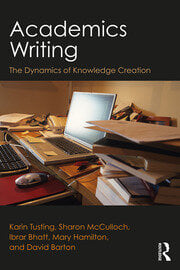What Makes Writing “Academic” in the Age of Generative AI?
If we see a significant change in the nature of academic writing, would that actually be a problem? As Molinari (2023: 18) notes the “genres, jargons, grammar, syntax and overall forms have been pejoratively described by writing scholars as straightjackets, chains, pigeonholes, frauds and hoaxes” not to mention the many critics for whom it is “discriminatory, elitist, exclusionary, colonial, dull, zombified and confusing”. I’ve often felt sceptical about these critiques because of their tendency to suggest that specialised writing is by its nature problematic, as opposed to reflecting the specific needs of an expert audience. To write in a vernacular which is adapted to the interests of this audience is only a problem if it’s the only way in which academics can write. Billig (2009: 9) suggests that public intellectuals can be thought of as bilingual in that “they use one language for addressing the public and another for addressing fellow specialists”. As long as there are at least some academics within each field who are willing and able to switch between these languages, I’m not convinced the problem with specialised language is that it excludes non-specialists.
The problem instead is that technical language often substitutes for clarity about what is being expressed in this technical jargon. When these terms are used in specific and precise ways they serve a purpose by simplifying communication. It’s easier for me to use the adjective ‘computational methods’ than it is to list a series of techniques for working with research data that have been made possible by technological advances in recent years. There might be uncertainty about how widely I’m drawing the category, but it can be safely assumed that everyone who recognises the phrase will understand the kinds of method I am talking about with this phrase. There will be people who are specialists who don’t understand the phrase. In which case I might have to list examples of the methods I’m describing, such as text mining, explaining how this relates to established forms of qualitative and quantitative work with texts that they will be familiar with. If they’re not a specialist then it’s likely another approach would be necessary, in which I pitch my explanation based on an assessment of their prior knowledge. The phrase would be a problem with this latter audience but the issue at stake is how to address non-specialist audiences in clear and effective ways.
This illustrates how, as Molinari (2023: 13) puts it, “what makes writing academic – its academicness – emerges from a complex stratified ontology of structures and agencies”. There’s not a defining feature of the text, a specific grammar and style, which gives it this academic quality. Nor is it simply a reflection of the fact it’s being written by people who occupy the social role of the academic. Academics write non-academic things continually. It seems implausible to say that our e-mails are a form of academic writing yet we write thousands of words of this form each week. I wrote a short story a few months ago. Is this academic writing? There are certainly academic themes to the writing, in that it was set in a university and explored themes of political crisis and civilisational crisis. But it didn’t feel like academic writing to me, nor do I suspect that anyone who reads my academic work would regard it as such. It’s not simply the fact we get published in a particular location either, because the unpublished manuscripts sitting in the (by now figurative) filing cabinet are academic writing even if they’ve not been made public. It could be argued that these are at least intended to be published, which would imbue journals with the capacity to render writing academic if the author seeks to publish it there. But as someone who has been blogging for over twenty years, I find this an obviously limited way to account for the meaning of the adjective. The six thousand posts on my blog are mostly academic but there are vast quantities of material which have nothing to do with my academic life either. I would struggle to offer a general account of the difference between these categories, even if it would be easy to make the distinction on a case-by-case basis. It’s not straightforward what makes writing academic even if we might have been taught in a way that suggests otherwise.
It follows from this that academic writing will always be subject to change and development. This doesn’t mean that there will be continual change but rather that its nature is not fixed, even if it sometimes feels like it is. The role of power in enforcing these judgements, whether the supervisor presenting their stylistic preferences as received wisdom or the journal reviewer demanding adherence to their instructions, compounds this sense of fixity. They are at least in those interactions fixed elements of the landscape which the academic writer is pressured to adapt to. While you don’t have to accept their judgements as the gospel truth, rejecting them incurs costs which you must negotiate in the development of your academic career. This gives them a force which can often be an object of resentment, leaving academic writing positioned precariously as both an expression of intellectual creativity and something we are forced to do in ways that count as a condition of employment. It can be hard to be reflective about academic writing when it so frequently feels so ambivalent to us. But unless we are reflective about it, we are likely to continue forward in the same way we have until something forces us to change.
This isn’t uniquely a feature of machine writing. The encounter of academics with digital media, first through blogging and then through social platforms, provoked similar anxieties. The change it required led some to worry that digital engagement would unavoidably lead to the abandonment of scholarly virtues. Now we’re experiencing similar concerns about AI’s impact on academic writing. But perhaps we’re focusing too much on the technology itself and not enough on the cultural and economic context in which we’re using it.
Instead of treating LLMs as an actor in their own right, we need to examine “the cultural and economic values that currently shape AI’s affordances”. As Vallor (2024: loc 2077) points out, “we ourselves are measured in terms of our ability to resemble our own mechanical mirrors”:
“Whether it’s the pressure to produce your next album, or publish enough to get tenure, or film enough videos to see your subscribers – our dominant values favour those who don’t get writer’s block, who don’t struggle to find the right words, or images, or notes, or movements, who never get caught up in the swirling drag of inexpressible meanings. Our economic order has long rewarded creators who work like machines. Should we really be surprised that we finally just cut out the middleman and built creative machines?”
If academics are inclined to draw on machine writing in order to maximise their productivity, we need to ask why this is. What is it about the training they undergo and the incentives they confront which leads them to seek to produce as much as possible, as quickly as possible? The affordances of LLMs offer an opportunity to radically expand the quantity of what is being produced but what is it which lead some academics to want to take advantage of that opportunity? In this sense we need to treat AI as a mirror, to use Vallor’s (2024) metaphor, which is held up to our existing social arrangements. If machine writing is bringing out the worst in academic writers we need to examine what it is about academic writers which leads them to engage with machine writing in this way. If we simply treat machine writing as if it is an enemy at the gate, a foreign intruder which needs to be repelled lest an otherwise well-functioning system be damaged, we lose the opportunity to grapple with the real changes taking place in academia.
Perhaps the most valuable question isn’t “How will Generative AI change academic writing?” but rather “What does our response to Generative AI reveal about the state of academic writing today?” The anxieties, temptations, and opportunities presented by these technologies hold up a mirror to the pressures and contradictions already embedded in academic practice. These are pressures that existed long before ChatGPT or Claude appeared on the scene.
#academicLabour #academicWriting #digitalScholarship #JuliaMolinari #michaelBillig #writing


